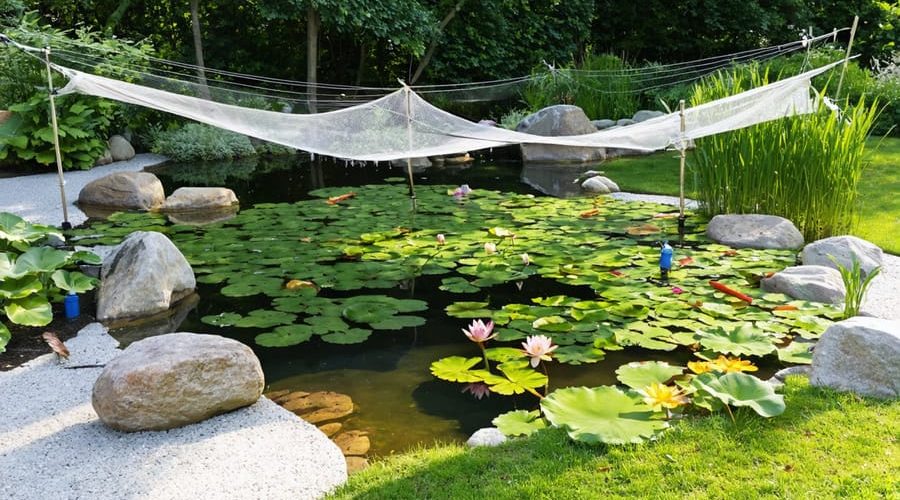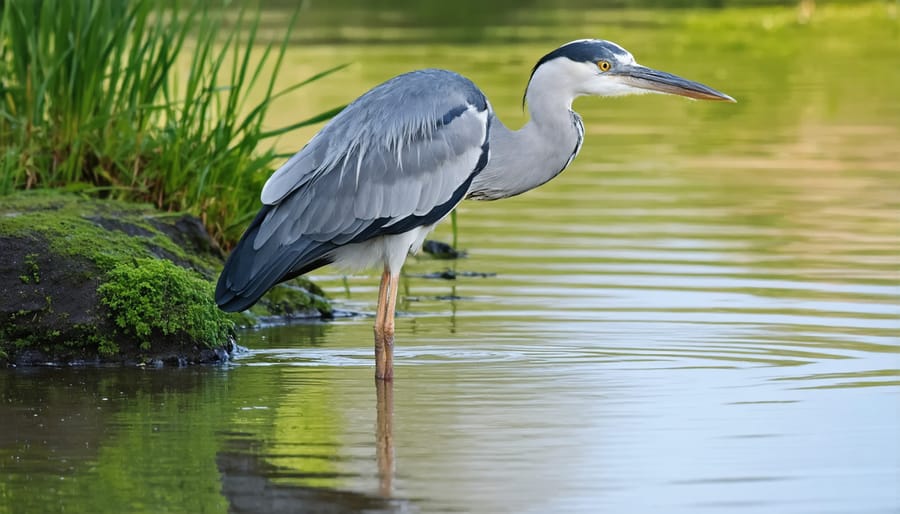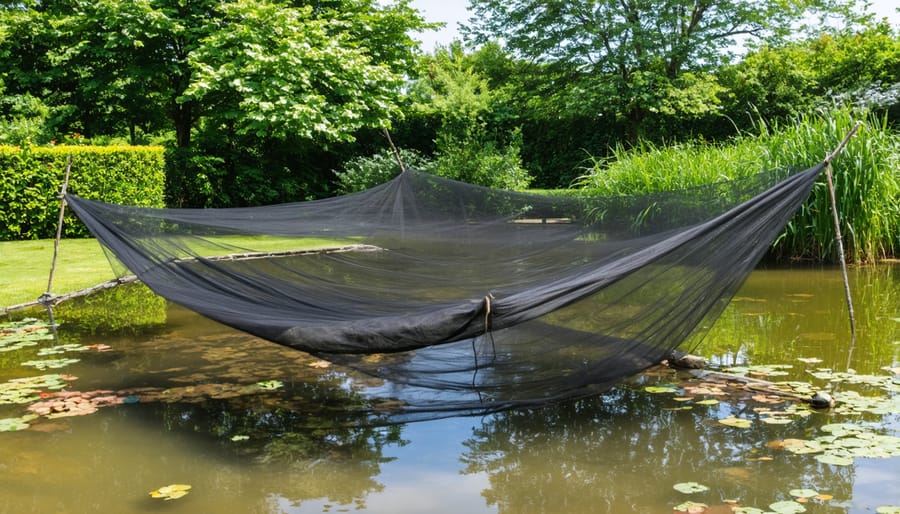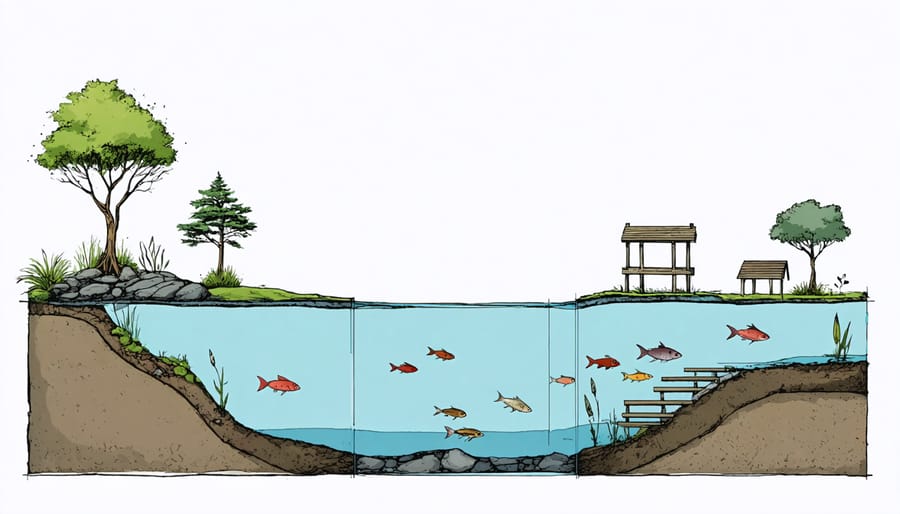
Save Your Pond Fish: Proven Defense Strategies Against Natural Predators
Protect your pond’s precious inhabitants with a multi-layered defense system that outsmart natural predators. From graceful koi to delicate goldfish, these underwater treasures face constant threats from herons, raccoons, and other wildlife seeking an easy meal. Creating a secure environment doesn’t mean sacrificing your pond’s natural beauty – modern protection methods blend seamlessly with water garden aesthetics while providing robust security.
Whether you’re a new pond owner or a seasoned enthusiast, understanding predator behavior and implementing effective deterrents is crucial for maintaining a thriving aquatic ecosystem. With strategic planning and the right combination of physical barriers, electronic deterrents, and natural camouflage, you can create a safe haven for your aquatic pets while preserving the tranquil beauty of your water garden.
This comprehensive guide explores proven protection strategies, from immediate solutions you can implement today to long-term defensive measures that will safeguard your pond for years to come. Let’s dive into the most effective methods for keeping your finned friends safe from unwanted visitors while maintaining the peaceful atmosphere of your backyard oasis.
Know Your Enemy: Common Pond Predators
Aerial Threats
Aerial predators pose a significant challenge for pond owners, with herons being the most notorious fish-snatchers. These elegant but opportunistic birds can quickly deplete your pond’s fish population if left unchecked. Herons typically hunt during early morning hours, standing motionless at the pond’s edge before striking with lightning speed.
Kingfishers, though smaller than herons, are equally skilled hunters. Their distinctive diving technique allows them to pluck fish directly from the water, making them particularly challenging to deter. Other aerial threats include cormorants, egrets, and even some species of ducks that may prey on smaller fish and fish fry.
To protect against these winged visitors, consider installing a combination of deterrents. Netting suspended above the pond creates a physical barrier while maintaining visibility. Decoy herons can be effective initially, but remember to move them regularly as birds quickly learn they’re fake. Motion-activated sprinklers offer a humane solution, startling birds when they approach.
Creating deeper areas (at least 4 feet) in your pond gives fish safe zones to retreat when threatened. Adding floating plants like water lilies provides natural cover, while strategic placement of rocks and overhanging vegetation creates additional hiding spots. These features not only protect your fish but also enhance your pond’s natural appearance.
Remember that different birds may require different deterrent strategies, so be prepared to adapt your protection methods as needed.

Ground-Based Predators
Ground-based predators can be some of the most persistent threats to your pond fish, with raccoons leading the pack as clever and determined hunters. These masked bandits are excellent problem-solvers and will return night after night once they discover your pond. To deter raccoons, install motion-activated lights and sprinklers around your pond area, and avoid leaving pet food outdoors that might attract them.
Domestic and feral cats are another common concern for pond owners. While they primarily hunt at the pond’s edge, cats are patient hunters and can wait hours for fish to swim close to the surface. Creating steep pond edges and maintaining water depths of at least 2 feet will help keep fish out of reaching distance.
Other ground predators to watch out for include mink, foxes, and even domestic dogs. A physical barrier like mesh fencing or netting can provide excellent protection against these threats. Install the barrier at least 2 feet high around your pond’s perimeter, ensuring it’s firmly secured to prevent animals from pushing underneath.
For additional protection, consider adding floating plants to provide natural cover for your fish. Water lilies and other floating vegetation not only add beauty to your pond but also create safe hiding spots where fish can retreat when they sense danger. Remember to maintain clear sight lines around your pond so predators can’t use tall grass or dense vegetation as stalking cover.
Physical Barriers That Actually Work
Netting Solutions
Netting offers one of the most effective solutions for year-round predator protection, particularly against birds and other aerial threats. The key is choosing the right type of netting and installing it properly to ensure both protection and aesthetics.
For smaller ponds, consider using fine mesh netting with holes no larger than 1/2 inch. This prevents even smaller predatory birds from reaching through while still allowing debris to fall through. Larger ponds benefit from heavy-duty polypropylene netting, which offers superior durability and can span wider areas without sagging.
To install pond netting effectively, start by measuring your pond’s surface area and add an extra 2-3 feet on each side. This overhang ensures complete coverage and prevents predators from reaching around the edges. Use sturdy stakes or poles around the pond’s perimeter, positioning them about 3-4 feet above the water surface. This height keeps the netting well above the water, preventing it from sagging and allowing plants to grow naturally.
For a cleaner look, consider a frame system made from PVC pipes or metal hoops. These create an dome-like structure that keeps the netting taut and elevated. Remember to secure the netting edges with landscape pins or heavy rocks to prevent gaps where predators might enter.
During seasonal changes, inspect your netting regularly for tears or damage. Remove fallen leaves and debris promptly to prevent the netting from becoming weighted down. For ponds with water features, create access points in the netting for maintenance while maintaining the protective barrier against unwanted visitors.

Floating Deterrents
Floating deterrents offer an aesthetically pleasing and effective way to protect your pond while maintaining its natural beauty. These surface-level solutions work by creating movement and visual barriers that make predators think twice before approaching your pond.
One of the most popular floating deterrents is the floating decoy. Plastic herons, alligator heads, and even swan decoys can help deter real predators from approaching. For best results, move these decoys regularly to prevent predators from getting used to their presence.
Motion-activated floating fountains serve a dual purpose – they not only create beautiful water displays but also startle predators with sudden movement and sprays. The unpredictable nature of these fountains makes them particularly effective against birds and other wildlife.
Floating plants like water lilies and lotus provide natural cover for fish while making it harder for predators to spot potential prey from above. These plants also add beauty to your pond and help maintain water quality. Consider covering about 60% of your pond’s surface with floating vegetation for optimal protection.
Another effective option is using floating nets or mesh. These lightweight barriers rest just above the water’s surface, making it difficult for predators to access the pond while remaining nearly invisible from a distance. During high-risk seasons, like spring when herons are most active, you can easily deploy and remove these nets as needed.
For added effectiveness, combine floating deterrents with other protection methods. Remember to regularly maintain and adjust your floating deterrents to ensure they continue working effectively throughout the seasons.
Smart Design Features for Natural Protection
Deep Zones and Fish Shelters
Creating deep zones in your pond is one of the most effective ways to protect your fish from predators. A pond with varying depths provides natural hiding spots where fish can quickly retreat when they sense danger. Aim to include areas that are at least 4-5 feet deep, as most predators won’t venture into these deeper waters.
Fish shelters can be both natural and artificial. Consider adding underwater structures like clay pots laid on their sides, sections of large PVC pipe, or purpose-built fish caves. These provide instant sanctuary for your finned friends when they need to hide. Rock overhangs and submerged logs also create excellent hiding spots while maintaining a natural look.
When placing shelters, arrange them in different areas of the pond, especially near the deeper zones. This gives fish multiple escape routes and prevents them from becoming trapped in a single area. Floating plants like water lilies offer additional protection by creating shadowy areas where fish can hide beneath their leaves.
Remember to maintain clear paths between shelters so fish can move freely from one safe spot to another. For the best protection, combine different types of shelters – mix artificial caves with natural rock formations and plantings. This creates a complex underwater environment that not only protects your fish but also enhances the overall ecosystem of your pond.

Strategic Plant Placement
Strategic plant placement around your pond creates a natural and beautiful defense system against predators. By incorporating protective pond plants, you can provide your fish with plenty of places to hide while enhancing your pond’s overall appearance.
Start by placing tall marginal plants like cattails or rushes around the pond edges. These create a physical barrier that makes it harder for herons and other predatory birds to land and wade. Next, add floating plants like water lilies and lotus, which provide essential cover for fish when viewed from above. Aim to cover about 50-60% of your pond’s surface with floating vegetation.
Submerged plants like hornwort and anacharis offer additional hiding spots beneath the water’s surface. Plant these in clusters around the deeper areas of your pond where fish naturally retreat when threatened. Remember to maintain clear spaces between plant groups to allow fish easy movement between hiding spots.
For maximum effectiveness, create multiple layers of protection by combining different plant types. Place shorter marginal plants in front of taller ones, and ensure floating plants are distributed evenly across the pond’s surface. This natural approach not only protects your fish but also creates a thriving ecosystem that benefits all pond inhabitants.
Electronic and Motion-Based Solutions
Modern technology has revolutionized the way we protect our ponds from unwanted visitors. These electronic and motion-based solutions offer some of the most effective humane predator deterrence methods available today.
Motion-activated sprinklers are a popular choice among pond owners. When a predator approaches, these clever devices shoot a quick burst of water, startling the animal without causing harm. Most predators learn quickly and tend to avoid the area after just a few encounters. Place these sprinklers strategically around your pond’s perimeter for maximum coverage.
Electronic deterrent devices emit ultrasonic sounds that many predators find uncomfortable. These sounds are typically inaudible to humans but effectively keep away herons, raccoons, and other unwanted visitors. Some models include flashing lights for added effectiveness during nighttime hours.
Solar-powered predator lights are another excellent option. These lights create random flash patterns that simulate the presence of another predator, making the area appear unsafe to potential threats. They’re especially effective against nocturnal predators and require no electrical connection – just place them around your pond and let the sun do the charging work.
For tech-savvy pond owners, motion-sensing cameras with smartphone connectivity provide real-time alerts when predators approach. This allows you to take immediate action and helps you understand which times of day your pond is most vulnerable. Some systems even include two-way speakers, enabling you to remotely scare away predators with your voice.
Remember to rotate or reposition these devices periodically, as clever predators may eventually learn to ignore static deterrents. Combining different electronic solutions often provides the best results, creating multiple layers of protection for your precious pond inhabitants.
Protecting your pond from predators doesn’t have to be a daunting task. By implementing a combination of the strategies we’ve discussed, you can create a safe haven for your aquatic pets while maintaining the natural beauty of your water garden. Remember that layered protection works best – combining physical barriers like netting with deterrent devices and natural landscaping elements provides the most comprehensive security.
Start with the basics: install adequate fencing or netting, especially during vulnerable periods like spring spawning. Add some strategic landscaping with protective plants and rocks to eliminate easy access points. Motion-activated sprinklers and lighting systems can serve as your second line of defense, while deeper areas and fish shelters give your pond inhabitants a fighting chance against opportunistic predators.
Don’t forget that regular monitoring and maintenance of your protective measures is just as important as installing them. Check your barriers for damage, ensure deterrent devices are working properly, and adjust your strategy based on the specific predator challenges in your area.
Most importantly, be patient and persistent. It may take some time to find the perfect combination of protection methods that works for your specific situation. The investment in proper predator protection is well worth the effort when you can relax and enjoy your thriving pond ecosystem without constant worry about unwanted visitors.
